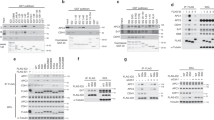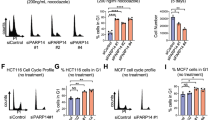Abstract
Transforming viral proteins such as E1A force cells through the restriction point of the cell cycle into S phase by forming complexes with two cellular proteins1,2,3: the retinoblastoma protein (Rb)4, a transcriptional co-repressor5, and CBP/p300 (ref. 6), a transcriptional co-activator7,8,9. These two proteins locally influence chromatin structure: Rb recruits a histone deacetylase10,11,12, whereas CBP is a histone acetyltransferase13,14. Progression through the restriction point is triggered by phosphorylation of Rb, leading to disruption of Rb-associated repressive complexes and allowing the activation of S-phase genes15. Here we show that CBP, like Rb, is controlled by phosphorylation at the G1/S boundary, increasing its histone acetyltransferase activity. This enzymatic activation is mimicked by E1A.
This is a preview of subscription content, access via your institution
Access options
Subscribe to this journal
Receive 51 print issues and online access
$199.00 per year
only $3.90 per issue
Buy this article
- Purchase on Springer Link
- Instant access to full article PDF
Prices may be subject to local taxes which are calculated during checkout




Similar content being viewed by others
References
Wang, H. G., Moran, E. & Yaciuk, P. E1A promotes association between p300 and pRB in multimeric complexes required for normal biological activity. J. Virol. 69, 7917–7924 (1995).
Dyson, N. & Harlow, E. Adenovirus E1A targets key regulators of cell proliferation. Cancer Surv. 12, 161–195 (1992).
Wang, H. G. et al. Identification of specific adenovirus E1A N-terminal residues critical to the binding of cellular proteins and to the control of cell growth. J. Virol. 67, 476–488 (1993).
Kouzarides, T. Transcriptional control by the retinoblastoma protein. Semin. Cancer Biol. 6, 91–98 (1998).
Weintraub, S. J., Prater, C. A. & Dean, D. C. Retinoblastoma protein switches the E2F site from positive to negative element. Nature 358, 259–261 (1992).
Chrivia, J. C. et al. Phosphorylated CREB binds specifically to the nuclear protein CBP. Nature 265, 855–859 (1993).
Lundblad, J. R., Kwok, R. P., Laurance, M. E., Harter, M. L. & Goodman, R. H. Adenoviral E1A-associated protein p300 as a functional homologue of the transcriptional co-activator CBP. Nature 374, 85–88 (1995).
Kwok, R. P. et al. Nuclear protein CBP is a co-activator for the transcription factor CREB. Nature 370, 223–226 (1994).
Arany, Z., Newsome, D., Oldread, E., Livingston, D. M. & Eckner, R. Afamily of transcriptional adaptor proteins targeted by the E1A oncoprotein. Nature 374, 81–84 (1995).
Magnaghi-Jaulin, L. et al. Retinoblastoma protein represses transcription by recruiting a histone deacetylase. Nature 391, 601–605 (1998).
Brehm, A. et al. Retinoblastoma protein recruits histone deacetylases to repress transcription. Nature 391, 597–601 (1998).
Luo, R. X., Postigo, A. A. & Dean, D. C. Rb interacts with histone deacetylase to repress transcription. Cell 92, 463–473 (1998).
Bannister, A. J. & Kouzarides, T. The CBP co-activator is a histone acetyltransferase. Nature 384, 641–643 (1996).
Ogryzko, V. V., Schiltz, R. L., Russanova, V., Howard, B. H. & Nakatani, Y. The transcriptional coactivators p300 and CBP are histone acetyltransferases. Cell 87, 953–959 (1996).
Weinberg, R. A. The retinoblastoma gene and gene product. Cancer Surv. 12, 43–57 (1992).
Kitabayashi, I. et al. Phosphorylation of the adenovirus E1A-associated 300 kDa protein in response to retinoic acid and E1A during the differentiation of F9 cells. EMBO J. 14, 3496–3509 (1995).
Yaciuk, P. & Moran, E. Analysis with specific polyclonal antiserum indicates that the E1A-associated 300-kDa product is a stable nuclear phosphoprotein that undergoes cell cycle phase-specific modification. Mol. Cell. Biol. 11, 5389–5397 (1991).
Perkins, N. D. et al. Regulation of NF-κB by cyclin-dependent kinases associated with the p300 coactivator. Science 275, 523–527 (1997).
Borrow, J. et al. The translocation t(8;16)(p11;p13) of acute myeloid leukaemia fuses a putative acetyltransferase to the CREB-binding protein. Nature Genet. 14, 33–41 (1996).
Trouche, D. & Kouzarides, T. E2F1 and E1A(12S) have a homologous activation domain regulated by RB and CBP. Proc. Natl Acad. Sci. USA 93, 1439–1442 (1996).
Nevins, J. R., DeGregori, J., Jakoi, L. & Leone, G. Functional analysis of E2F transcription factor. Methods Enzymol. 283, 205–219 (1997).
Goldman, P. S., Tran, V. K. & Goodman, R. H. The multifunctional role of the co-activator CBP in transcriptional regulation. Recent Prog. Horm. Res. 52, 103–119 (1997).
Eckner, R., Yao, T. P., Oldread, E. & Livingston, D. M. Interaction and functional collaboration of p300/CBP and bHLH proteins in muscle and B-cell differentiation. Genes Dev. 10, 2478–2490 (1996).
Puri, P. L. et al. Differential roles of p300 and PCAF acetyltransferases in muscle differentiation. Mol. Cell 1, 35–45 (1997).
Korzus, E. et al. Transcription factor-specific requirements for coactivators and their acetyltransferase functions. Science 279, 703–707 (1998).
Ramirez, S., Ait-Si-Ali, S., Robin, P., Trouche, D. & Harel-Bellan, A. The CREB-binding protein (CBP) cooperates with the serum response factor for transactivation of the c-fos serum response element. J. Biol. Chem. 272, 31016–31021 (1997).
Swope, D. L., Mueller, C. L. & Chrivia, J. C. CREB-binding protein activates transcription through multiple domains. J. Biol. Chem. 271, 28138–28145 (1996).
Martinez-Balbas, M. A. et al. The acetyl-transferase activity of CBP stimulates transcription. EMBO J. 17, 2886–2893 (1998).
Groisman, R. et al. Physical interaction between the mitogen-responsive serum response factor and myogenic bHLH proteins. J. Biol. Chem. 271, 5258–5264 (1996).
Ait-Si-Ali, S., Ramirez, S., Robin, P., Trouche, D. & Harel-Bellan, A. Arapid and sensitive assay for histone acetyl-transferase activity. Nucleic Acids Res. 26, 3869–3870 (1998).
Acknowledgements
We thank Z. Mishal and A. Vervisch for help with cell-cycle analysis; T. Kouzarides, L. Meijer and D. A. Lawrence for the gift of materials; F. Dautry for critical reading of the manuscript; and A. Damany for her support. This work was supported by grants from the Ligue Nationale contre le Cancer, the Comité des Yvelines, the Comité de l'Essone and the Comité du Val de Marne, from the Association pour la Recherche sur le Cancer and from the Groupement des Entreprises Françaises dans la Lutte contre le Cancer. S.A.-S.-A. was awarded a fellowship from the Comité de la Haute-Saône; S.R., a travel award from the Colombian Government (Colciencias); F.-X.B., a fellowship from the Agence Nationale pour la Recherche sur le Sida; L.M.-J. and F.D., fellowships from the Comité de l'Essone.
Author information
Authors and Affiliations
Corresponding author
Rights and permissions
About this article
Cite this article
Ait-Si-Ali, S., Ramirez, S., Barre, FX. et al. Histone acetyltransferase activity of CBP is controlled by cycle-dependent kinases and oncoprotein E1A. Nature 396, 184–186 (1998). https://doi.org/10.1038/24190
Received:
Accepted:
Issue Date:
DOI: https://doi.org/10.1038/24190
This article is cited by
-
Update and Potential Opportunities in CBP [Cyclic Adenosine Monophosphate (cAMP) Response Element-Binding Protein (CREB)-Binding Protein] Research Using Computational Techniques
The Protein Journal (2021)
-
Beyond transcription factors: how oncogenic signalling reshapes the epigenetic landscape
Nature Reviews Cancer (2016)
-
MicroRNA-22 targeting CBP protects against myocardial ischemia–reperfusion injury through anti-apoptosis in rats
Molecular Biology Reports (2014)
-
In vitro analysis of ovarian cancer response to cisplatin, carboplatin, and paclitaxel identifies common pathways that are also associated with overall patient survival
British Journal of Cancer (2012)
-
Epigenetic modulation of host: new insights into immune evasion by viruses
Journal of Biosciences (2010)
Comments
By submitting a comment you agree to abide by our Terms and Community Guidelines. If you find something abusive or that does not comply with our terms or guidelines please flag it as inappropriate.



